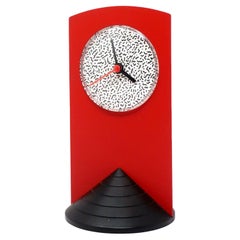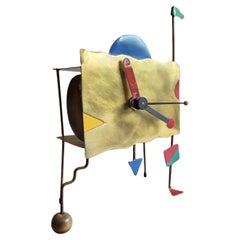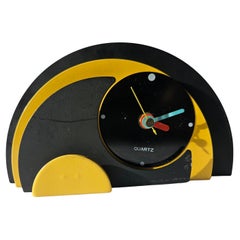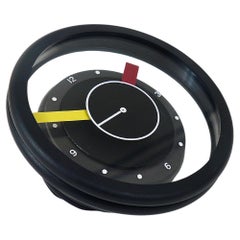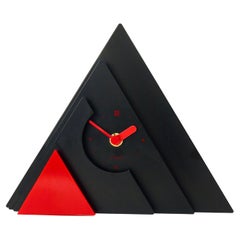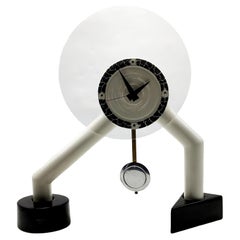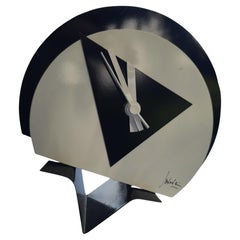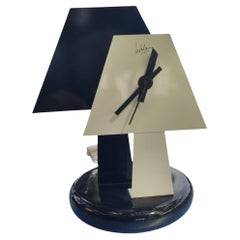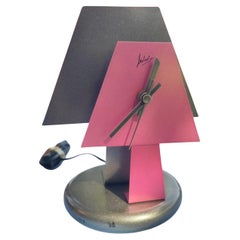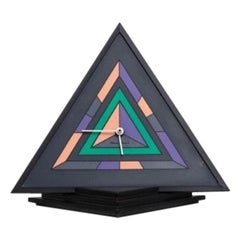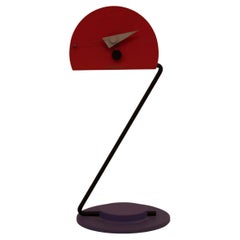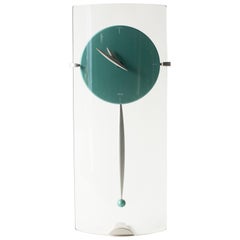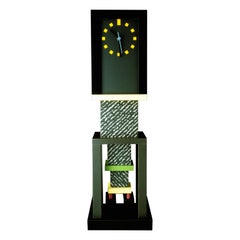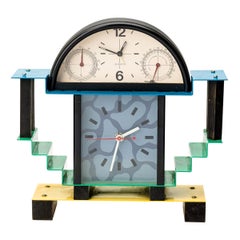Memphis Table Clocks
Late 20th Century Post-Modern Table Clocks and Desk Clocks
Plastic
Late 20th Century Dutch Post-Modern Table Clocks and Desk Clocks
Copper
Vintage 1970s Italian Mid-Century Modern Table Clocks and Desk Clocks
Metal
1990s Post-Modern Table Clocks and Desk Clocks
Plastic, Plexiglass, Rubber
Vintage 1980s Post-Modern Table Clocks and Desk Clocks
Metal
Vintage 1980s Italian Mid-Century Modern Table Clocks and Desk Clocks
Ceramic
Vintage 1980s Italian Post-Modern Table Clocks and Desk Clocks
Metal
Vintage 1980s Italian Post-Modern Table Clocks and Desk Clocks
Metal
Vintage 1980s Italian Post-Modern Table Clocks and Desk Clocks
Metal
20th Century Italian Post-Modern Table Clocks and Desk Clocks
Metal
Vintage 1980s Table Clocks and Desk Clocks
Metal
1990s Japanese Post-Modern Table Clocks and Desk Clocks
Glass, Plastic
Recent Sales
Vintage 1980s Post-Modern Table Clocks and Desk Clocks
Aluminum, Brass, Enamel
20th Century Unknown Modern Table Clocks and Desk Clocks
Metal
20th Century Taiwanese Post-Modern Table Clocks and Desk Clocks
Marble
1990s American Post-Modern Table Clocks and Desk Clocks
Wood
Late 20th Century Post-Modern Table Clocks and Desk Clocks
Plastic
Vintage 1980s Japanese Post-Modern Table Clocks and Desk Clocks
Rubber
1990s Japanese Post-Modern Table Clocks and Desk Clocks
Steel
1990s American Post-Modern Painted Furniture
Wood
Vintage 1980s German Post-Modern Table Clocks and Desk Clocks
Plastic, Wood
Vintage 1980s Italian Mid-Century Modern Table Clocks and Desk Clocks
Plastic
Vintage 1980s Italian Post-Modern Table Clocks and Desk Clocks
Metal
Vintage 1980s English Post-Modern Table Clocks and Desk Clocks
Metal
20th Century American Post-Modern Table Clocks and Desk Clocks
Marble, Brass
Vintage 1980s Japanese Post-Modern Table Clocks and Desk Clocks
Plastic
Vintage 1980s Italian Mid-Century Modern Table Clocks and Desk Clocks
Stainless Steel
Late 20th Century Italian Modern Table Clocks and Desk Clocks
Steel
Vintage 1980s Japanese Post-Modern Table Clocks and Desk Clocks
Rubber
Late 20th Century German Post-Modern Table Clocks and Desk Clocks
Ceramic
1990s Japanese Post-Modern Table Clocks and Desk Clocks
Steel
Vintage 1980s Italian Post-Modern Table Clocks and Desk Clocks
Metal
Vintage 1980s Italian Post-Modern Table Clocks and Desk Clocks
Porcelain
People Also Browsed
Antique 19th Century Japanese Meiji Furniture
Mother-of-Pearl, Wood
Late 20th Century Danish Post-Modern More Desk Accessories
Plastic
Antique 1670s Floor Lamps
Stone, Silver, Bronze
Late 20th Century Swiss Kinetic Table Clocks and Desk Clocks
Metal
Vintage 1940s American Art Deco Wall Clocks
Metal
Early 20th Century American Art Nouveau Decorative Boxes
Spelter
Early 20th Century French Art Deco Bedroom Sets
Mid-20th Century French Art Deco Table Clocks and Desk Clocks
Chrome
Early 20th Century American Art Deco Decorative Boxes
Silver Plate
Vintage 1910s Bottles
Glass
20th Century Italian Animal Sculptures
Silver
Vintage 1930s Swedish Art Deco Decorative Boxes
Brass, Pewter
Vintage 1940s French Secretaires
Brass
Vintage 1910s Carriage Clocks and Travel Clocks
Silver, Enamel
Early 20th Century French Art Deco Mantel Clocks
Marble, Metal, Brass
Vintage 1940s French Art Deco Screens and Room Dividers
Mirror
Memphis Table Clocks For Sale on 1stDibs
How Much are Memphis Table Clocks?
Finding the Right Table-clocks-desk-clocks for You
Whether you’re working on-site or giving your home office the makeover it deserves, a new, vintage or antique table clock or desk clock is a decorative touch that blends ornament and functionality. Who says that a unique desk clock isn’t a meaningful addition to your home office or library? And who says you don’t need a cool clock anymore?
While our means for telling time have evolved from pocket watches to wristwatches and finally to our digital phones, there is likely still a place for a table clock or desk clock in your life, even if it isn’t a modern desk clock.
Antique and vintage clocks appeal to our penchant for nostalgia, whisking us back in time to the 18th and 19th centuries, when clockmakers were busying themselves with designs for objects such as mantel clocks, then ornate pieces that were typically displayed on top of a fireplace. Tabletop clocks and desk clocks are variations on the carriage clock, a small, portable timepiece outfitted with a hinged carrying handle that garnered popularity as the growth of rail travel took shape.
Clocks make great collectibles. More than one mantel clock in your home library is going to elevate the space where your carefully curated stacks of books live, while a well-designed small decorative desk clock can be a fun way to express your personal style. Amid your inkwell, porcelain paperweights and other desk accessories, a desk or table clock designed during the Art Deco or Louis XVI eras, for example, is going to stand out in your workspace as a striking accent.
Since new, vintage and antique tabletop and desk clocks are not as common in today’s interiors, these objects will make a statement in yours. Find a spectacular clock on 1stDibs now.
- 1stDibs ExpertApril 5, 2024To program an Arne Jacobsen Roman table clock, remove the back of the clock and locate the two knobs found on the back of the clear case. Turn one knob to change the time and the other to set the alarm. Shop a range of vintage table clocks on 1stDibs.
